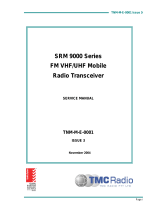Page is loading ...

©1993 Hamtronics, Inc.; Hilton NY; USA. All ri
g
hts reserved. Hamtronics is a re
g
istered trademark. Manual revised: 11/27/01 4:27 PM - Pa
g
e 1 -
GENERAL.
This application note describes gen-
eral procedures for using the Ham-
tronics® high-speed exciter and receiver
modules with equipment and modems
other than the MO-96, which these radio
modules were designed to be used with
normally.
DIFFERENCE BETWEEN
"HS" VERSIONS OF RADIOS
AND REGULAR VOICE TYPE.
Hamtronics makes special versions of
some of its fm exciters and receivers
which have been modified to operate on
narrow-band fm channels with 9600
baud data. These models have an "HS"
suffix on the model number to indicate
that they are optimized for high speed
data operation. These radios normally
are used with our MO-96 Modem, which
is designed expressly to interface with
packet radio TNC's (terminal node con-
trollers) which have a TTL signal inter-
face for data lines and a ground ptt
output as a transmitter keyline.
The normal exciters (TA51, TA451,
TA901) use a phase modulator in order
to obtain the best frequency stability,
since any component used in the oscilla-
tor circuit affects the frequency stability
with voltage and temperature changes.
The models optimized for 9600 baud
data, which have an "HS" suffix on the
model number, use a varactor diode in
the oscillator circuit to directly modulate
the crystal frequency.
The "HS" versions of our receivers
use special if filters which have a pass-
band style optimized for high-speed data
reception to provide low group delay dis-
tortion. In addition, they include special
connections for the AFC (automatic fre-
quency control) circuit to be used with a
special digital afc circuit in the MO-96
Modem.
EXCITER.
The exciter normally gets two signals
from the MO-96 Modem: a data signal
for the modulator and a keyline in the
form of switch +13.6Vdc to power the
exciter. Any equipment which is used in
place of the MO-96 must provide suit-
able substitutes.
The schematic below shows a circuit
which can be used to inject the data into
the varactor modulator in the exciter.
The varactor diode, of course, alters the
frequency of the channel crystal by
changing the load capacitance the crystal
sees. In order to function properly, the
equipment driving the varactor circuit
must set the exact channel frequency you
intend to operate on by setting the bias
voltage applied to the varactor diode.
This may be done with a precision pot
connected to a very stable voltage
source. The normal center voltage the
varactor wants to see is about +4.5Vdc.
In addition, the external equipment
must also have a method of adjusting the
deviation of the fm signal by adjusting
the level of the data signal swing. In the
MO-96 Modem, this is done with a se-
ries of op-amps having a gain control.
The op-amps also provide a very care-
fully controlled low-pass filtering to pre-
vent splatter by shaping the data signals.
Square-wave signals would cause the fm
signal to occupy much more than a nor-
mal narrow-band fm channel.
It is not easy to duplicate this filtering
function. Therefore, if you are in-
terested in an easy way to interface data
equipment with the exciter and receiver,
we recommend you consider using the
low-cost MO-96 Modem to provide the
interface.
KEYING CIRCUIT.
The MO-96 Modem provides an elec-
tronic switch to apply power to the ex-
citer whenever the computer equipment
sends a keyline signal. Your interface
circuits should include a similar circuit
which would respond to the command to
key up the transmitter. You can use a
power transistor with accompanying
driver transistor or a relay to perform
this function.
RECEIVER.
The receiver has two special facilities
for connection to the MO-96 Modem.
Data output to the modem is taken from
the DISCRIMINATOR terminal on the
receiver. It has a dc voltage centered at
about +4 Vdc, which varies up and
down in voltage with the data signal.
The MO-96 Modem normally does some
filtering on this raw discriminator signal
and has a digital slicer to construct the
logic signal for the computer equipment.
The receiver also has a special provi-
sion to connect the digital afc circuit of
the MO-96 Modem to be used in place of
the simple afc circuit in the basic voice-
style receiver. When the MO-96 is not
used with an "HS" type receiver, the
original afc circuit in the receiver must
be restored in order to have the channel
oscillator be tuned on-frequency prop-
erly.
APPLICATION NOTE: USING HAMTRONICS
®
9600 BAUD RADIOS
WITHOUT THE MO-96 MODEM
47K
+13.6VDC 9V
REGULATOR +
_
+
_47 UF 47 UF
+9VDC
20K
20 TURN
POT
5 UF
NON-
POLARIZED
5 UF
NON-
POLARIZED
TX DATA
TO MODULATOR
IN EXCITER
/

